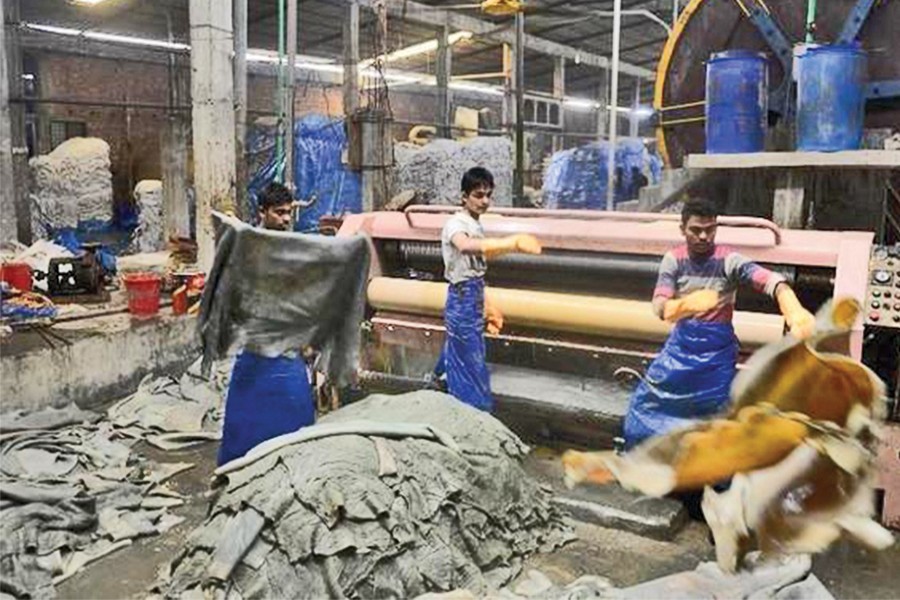The government is planning to impose tariff on export of crust leather, according to an official source.
The move will be to discourage and gradually squeeze shipment of unfinished leather from the country.
Moreover relevant authorities are also considering to withdraw the 5.0 per cent cash incentive, now being enjoyed by the tanneries exporting crust leather.
Such recommendations have been made in the Leather Sector Export Roadmap that is currently at the final stage of formulation.
The officials said the move is aimed at encouraging the local tanners to move up in the value chain, as the country is looking to earn US$ 5.0 billion from export of leather and leather goods by 2021.
Leather is the second largest export-earning sector for Bangladesh after ready-made garments.
The recent times, however, have seen a downward trend in the export of the item. The relocation of the tanneries from Hazaribag in the capital to Savar is often blamed for the setback.
In the first nine months of this fiscal year, 2017-18, export earnings from leather and leather goods have reached $ 916.74 million, which is $102.12 million lower than that of the corresponding period of the previous year.
Experts noted that increasing exports from leather sector in the long-term would also require moving up in the value chain for the local tanners.
According to industry insiders, less than 15 per cent of crust leather, coming from the local tanners, is converted into finished leather.
Finished leather has a greater market value, as it fetches about 60 per cent higher price than crust leather.
In this context, the draft roadmap has recommended imposing an export duty on crust leather following a two-year leniency period.
According to the sector insiders, this approach has been used and found to be successful in Kenya and Tanzania.
In addition, the roadmap has also recommended gradual withdrawal of 5.0 per cent cash incentive, currently enjoyed by the tanneries producing crust leather, after a leniency period of one year.
"We want to encourage the tanners to move up in the value chain," Ministry of Commerce (MoC) Additional Secretary Md. Obaidul Azam told FE.
"This can result in bringing significant economic gain for the sector while also creating new and better jobs in the tannery industry," he added.
Apart from disincentivising crust leather export, the new roadmap has also recommended several provisions for regulating the rampant discharge of effluent from tanneries.
For example, it has been recommended that at each relocated tannery in Savar, a 'tamper-free flow meter' must be installed to measure that the actual volume of effluent is discharged.
Tanneries in Bangladesh have long been associated with pollution. Since the beginning of their operations in the 1960s, the tanneries at Hazaribag were the major source of pollution of the Buriganga river.
It has been estimated that around 40 per cent pollution of Buriganga over the years has been caused by the tanneries.
In this context, the Supreme Court earlier ordered relocation of the tanneries from Hazaribag to the tannery estate in Savar.
Although, all the 155 tanneries have been relocated, it has often been pointed out that without an efficient Central Effluent Treatment Plant (CETP), the relocation move will only shift the pollution from Buriganga in Dhaka to the Dhaleshwari River in Savar.
In this context, the roadmap has provisioned an independent technical assessment of CETP and other treatment components, selection of a private operator for CETP through an international competitive bidding as well as conversion of solid waste produced by the tanneries into useful by-products.
In addition, it has been planned that the Ministry of Industries will collect data from the relocated tanneries regarding their capacity along with daily volume of effluent to be discharged by them.
It is estimated that if all the 155 tanneries together process less than or equivalent to 700 tonnes of raw materials per day, the volume of effluent discharged by them will be less than the capacity of the CETP.
However, if the total capacity proposed by the allottees or the volume of effluent generated by them exceeds either 700 tonnes or 20,000 cubic meter per day, steps will be needed to limit the effluent discharge.
Any tannery discharging more than allotted capacity may be penalised suitably by increasing the charge by 50 per cent or more as may be decided the relevant authority, the officials said.
To tackle the environment issue, the roadmap has also called for developing a compliance certification scheme and establishment of a Sustainability and Compliance Cell under the relevant industrial associations.
In addition, technical assistance will also be provided to guide 40 tanneries in obtaining Leather Working Group (LWG) clearance.
LWG certification is an internationally accepted and recognised certification for leather and leather-related products that are aligned with internationally accepted environmental protocols and priorities.
In addition, the roadmap has also suggested providing financial support for engaging international compliance experts, who will provide handholding support to tanneries on a need basis for 24 months.
This can be done on a 50-50 cost-sharing basis between the industrial associations, the MoC officials said.
The tanneries will apply for this funding assistance, based on a set of criteria to be determined by the Sustainability and Compliance Cell, they added.
Improving the social, environmental, safety, health, and chemical compliance can improve the acceptance of Bangladeshi leather across the world and also enhance the leather sector's export competitiveness, experts observed.


